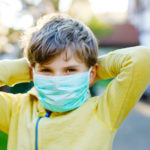by Erin Beck, Kids’ Health Correspondent
Some West Virginia children, unable to get enough oxygen on their own, have required intensive care and ventilators after contracting COVID-19, according to the state COVID czar and pediatricians. The number of children who’ve fallen severely ill and been admitted to the hospital increased along with the rise of the Delta variant, they said.
More than 300 kids have been hospitalized throughout the pandemic, and that number spiked throughout the last several months. But state officials are currently withholding intensive care and ventilator numbers from the public.
“They’re sick and in respiratory distress and that’s actually why they go to the intensive care unit because the level of oxygen they need is more than what we can handle on the floor,” said Dr. Kathy Moffett, a pediatric infectious disease specialist at WVU Medicine Children’s Hospital. “We have not had a single vaccinated kid hospitalized due to COVID.”
Dr. Lisa Costello, president of the West Virginia American Academy of Pediatrics chapter, also confirmed that children are ending up in intensive care and in hospitals.
“There are people who continue to think that children don’t get severe illness from COVID,” she said. “The problem with COVID and any illness really, but particularly with COVID, is we can’t predict who’s going to get that severe disease.”
The American Academy of Pediatrics and the Children’s Hospital Association releases a report on COVID-19 cases among children each week. In an interview earlier this month, I told Dr. Clay Marsh, the West Virginia COVID-19 czar and West Virginia University’s chief health officer, that I had been reviewing the reports and noticed West Virginia children were faring much worse than those in other states.
As of the most recent, Oct. 14 report, West Virginia had the fourth-highest rate of cumulative positive cases among children in the country. For every 100,000 children in the state, an estimated 14,159 contracted the disease. Nearly 60,000 youth 0-20 had contracted the virus.
West Virginia also had the fifth highest percent of cumulative COVID-19 cases that were children. Children represented 16.4 percent of cases nationwide, but 22.2 percent of cases in West Virginia.
Marsh said that previously, experts said children were protected.
“I think everybody is susceptible to this,” he said, referencing the more contagious Delta variant.
According to the Centers for Disease Control and Prevention, West Virginia reports 330 children have been hospitalized with the virus. The rate drastically increased in August through September and children continue to be hospitalized in West Virginia at a higher rate than any other point in the pandemic, according to the CDC.
Marsh said each day, members of West Virginia’s COVID-19 pandemic leadership team receive a report of adult and child COVID-19 hospitalizations. He said that day (Oct. 1), there were six children in intensive care and one requiring a ventilator, of ten children hospitalized for COVID-19 in the state. He said child hospitalization numbers had been “pretty consistently” in that range during the Delta surge.
He also said more kids are being hospitalized because more kids are contracting the disease.
“We definitely see more kids getting sick, getting infected and getting sick than we did at the January part of the pandemic… but we also see just a much greater number of children getting infected, which is why we’ve been such advocates for vaccinations in the children who are eligible,” he said.
At the governor’s request, the Legislature passed a sweeping vaccination exemption bill this week.
Marsh noted that a 17-year-old died in West Virginia, but that no very young children have.
“But they’ve been reported,” he said, referencing deaths in other states.”
I told him that I had hoped more child cases would mean more adults would get vaccinated, but that I hadn’t seen that happening.
“I think it’s an important consideration because the more disease you have, and the more spread you have, the more likely that will get to children as well,” he said.
“For others, altruism has not been as compelling as we would have hoped. So while I think that’s an important message, and one that we’ve tried to articulate before, I also think we’re at the point now where a lot of people are making their minds up based on information that they perceive as important, not necessarily the information that we would perceive as most important.”
Thinking that it might be more helpful to try to reach people who haven’t been able to get a vaccine, rather than convince those who don’t want to, I also suggested ways to reach children I had jotted down, such as reaching out to foster care placement agencies, families of children with IEPs, and residential facilities, among other ideas.
But Marsh said he also thought about how effective those types of efforts would be, and said he wondered about the role of trust in public officials, as well. He noted that some are worried about personal rights.
“And for a lot of the folks who are in that undecided or unsure category, or hesitant category, we’ve tried and will continue to try all the things we can do to help them choose to be vaccinated. But I do wonder at what point the sort of the approaching it negatively, or positively, or incentives or disincentives or messaging, when does that become more like noise.”
Since he mentioned trust, I told him that I have heard from public health workers that it’s important for them to have trusting relationships with their communities before disaster strikes, and that they need adequate funding to build those relationships. And I knew since the governor has consistently said he wouldn’t support mandates, I decided to ask about something less controversial that I thought he might be willing to support — more funding for health departments.
“I have to say, remember my role in this whole thing? I’m an advisor. And I am not an elected government official, and certainly not the governor.”
Governor Justice has been quick to cut ties with his employees throughout his tenure. Marsh is a volunteer.
WVU pediatrician sees two to six hospitalized kids per day
Moffett, a pediatric infectious disease specialist at WVU Medicine Children’s Hospital, said she didn’t have exact numbers of children hospitalized and those requiring ventilators and intensive care.
“But I’ll tell you, throughout the pandemic, we would see kids, and we’d have one or two, maybe three in the hospital,” she said. “And then from January, maybe February to July, we had very few.
“But I will tell you since July, the number of hospitalizations and intensive care unit hospitalizations has gone up what we feel is dramatically. So probably at any time now, we’ll have anywhere from two to five, maybe six kids in the hospital. And generally we’ve had — well we’ve had as many as all of them in our intensive care unit.”
I wanted to make sure that she didn’t mean two- six kids have been in the intensive care unit long-term or the whole time, so I asked her to clarify. Kids have typically stayed about three days, she said.
Kids are typically being admitted after they’ve had COVID-19 for eight- 12 days, she said. After developing a cough and congestion, their cough worsens and they get short of breath.
Obesity has been the number one risk factor, Moffett said. They’ve also seen kids with underlying conditions of cancer and sleep apnea.
one risk factor, Moffett said. They’ve also seen kids with underlying conditions of cancer and sleep apnea.
“They should have been counseled that they are at high risk for severe COVID,” she said.
Since July, they’ve been treating kids 12 or older with monoclonal antibodies.
“I think we have prevented some kids from being hospitalized, because if they have a risk factor of underlying disease, obesity, diabetes, heart disease, lung disease, and they get COVID, then they’re eligible.”
She said it’s too early to predict whether her patients will have long-term health effects, but that WVU did receive funding to follow and study some of them.
She also cautioned that parents should watch for symptoms of Multisystem Inflammatory Syndrome in Children in kids who had COVID previously, although she said those symptoms usually appear in kids who had COVID-19 before the rise of the Delta variant. Symptoms include high fever, stomach pain, diarrhea, she said. Some have heart and breathing issues.
“You don’t find that they have acute active infection,” she said. “But when you do serology or the blood test, you find out that they have had recent COVID. The family will say well, a month ago everybody in the family had it. And the child maybe had one day with a stuffy nose and a low-grade fever and then they were fine.”
She urged guardians whose kids are diagnosed with COVID-19 and have one of the risk factors to come in earlier for the infusion.
State officials have talked about being over the Delta peak. Moffett said numbers are down a little. But she cautioned about widespread infection among kids in the community. She noted that it took three months, from July to October, to reach a peak.
“It’s going to take us another three months to get where we were in July,” she said.”That’s very staggering to say, well, we may be on the downturn, but we still have a long way to go.
State officials keeping child hospitalization data private
Dr. Marsh told me the leadership team requested daily hospitalization reports months ago because they were concerned about the Delta variant.
I asked for copies of previous reports, so he referred me to the governor’s office.
I requested copies of those reports from the governor’s office June 1 to present on Monday, Oct. 4 at 5 p.m. The state’s open records law allows five days for state agencies to fulfill the request. And Marsh said the reports were already in email format.
present on Monday, Oct. 4 at 5 p.m. The state’s open records law allows five days for state agencies to fulfill the request. And Marsh said the reports were already in email format.
Tuesday, Oct. 19, Berkeley Bentley, a lawyer for the governor, sent a letter denying the request.
Brian Abraham, chief of staff for the governor, then told me, via email, it was his “best belief” the governor’s office did not receive those reports and to contact the state Department of Health and Human Resources, which as of Wednesday night had not responded to my Tuesday records request.
More:
- White House details plan to roll out Covid-19 vaccines for children ages 5 to 11 – CNN Oct. 20. “Vaccine advisers to the FDA are scheduled to meet next week to consider Pfizer’s request to authorize its vaccine to children ages 5 to 11.”
- West Virginia currently has the third-highest COVID-19 death rate, as measured by looking at a seven-day average. The state had the highest death rate for the past several weeks.
- According to the CDC, weekly COVID-19–associated hospitalization rates among children and adolescents rose nearly five-fold during late June–mid-August 2021, coinciding with the spread of the highly transmissible Delta variant. Children were hospitalized at roughly the same rate as they were during the spread of previous variants, but more children were being diagnosed, leading to more hospitalization. The CDC said hospitalization rates were 10 times higher among unvaccinated than among fully vaccinated adolescents.
- More kids hospitalized with Covid-19 in states with lower vaccination rates, CDC report finds- CNN
- “How West Virginia became a Covid-19 disaster”- CNN
- Kanawha boy, 17, dies of COVID-19; Hoyer urges patience on vaccines as shipments fall short – Charleston Gazette-Mail
- ‘She was my little piece of Heaven’: 15-year-old St. Albans High sophomore dies- Charleston Gazette-Mail
- 2-year-old with COVID-19 placed on ventilator. What parents of kids under 5 should know – Good Morning America







0 Comments